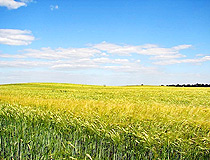Dnipropetrovsk Oblast - Overview
Dnipropetrovsk Oblast or Dnipropetrovska Oblast is an administrative region located in the middle and lower reaches of the Dnieper River, in the southeastern part of Ukraine. Dnipro is the capital city of the region.
The population of Dnipropetrovsk Oblast (2021) is about 3,096,000 (7.52% of the total population of Ukraine).
The area of Dnipropetrovsk Oblast is 31,923 sq. km. (5.28% of the total area of Ukraine).
Dnipropetrovsk Oblast - Features
In 2016, the capital of the region, the city of Dnipro, was renamed from Dnipropetrovsk during the decommunization. The Dnipropetrovsk region itself still retains this name, since it requires amending the Constitution of Ukraine.
February 7, 2019, the deputies of the Verkhovna Rada (The Parliament of Ukraine) supported the bill on renaming the Dnipropetrovsk region to Sicheslavska. If the Constitutional Court of Ukraine does not find violations, most probably the Dnipropetrovsk region will be renamed to Sicheslavska, in honor of the Cossack Sich.
The length of the region from north to south is 130 km, from west to east - 300 km. For the most part, the landscape of the Dnipropetrovsk region is a plowed steppe, in the floodplains of rivers there are forests, the largest forest is the Samara forest with an area of about 15,000 hectares.
The climate of the region is moderately continental: mild low-snow winters with frequent thaws (the average temperature in January is minus 2-5 degrees Celsius) and hot, dry summers with frequent rainfall and strong southerly winds (the average temperature in July - plus 20-24 degrees Celsius).
217 rivers flow in the region, of which 55 are more than 25 km long. The main waterway, the Dnieper River, crosses the region from northwest to southeast.
The Dnipropetrovsk region is unique in its mineral reserves (about 50% of all Ukrainian mineral reserves). It produces 100% of Ukrainian manganese, 80% of iron ore, as well as coal, uranium, rare earth metals, kaolin and granites, oil and natural gas. In total, this region produces 39 types of mineral raw materials.
Favorable natural and climatic conditions of the Dnipropetrovsk region allow intensive agriculture, contribute to the cultivation of all grain crops and produce high-quality food grain. All types of agricultural crops are grown in the region, up to 3 million tons of cereals are harvested annually.
The largest cities of the Dnipropetrovsk region are Dnipro, Kryvyi Rih, Kamianske, Nikopol, Pavlohrad. About 85% of the population lives in cities and towns.
In the 1950s-1980s, the Dnipropetrovsk region was one of the most economically and politically influential regions of the Ukrainian SSR and the entire Soviet Union.
Petrykivka painting or simply “Petrykivka” is a Ukrainian decorative and ornamental folk painting style, which was formed in the Dnipropetrovsk region in the village of Petrykivka. Household items with patterns in the style of Petrykivka have been preserved since the 17th century.
Landscapes of Dnipropetrovsk Oblast

Dnipropetrovsk region landscape
Author: Alexander Kesariysky

Dnipropetrovsk oblast landscape
Author: Alexander Kesariysky

Dnipropetrovsk province field
Author: Dmitriy Uranus
Dnipropetrovsk Oblast - Economy
The Dnipropetrovsk region is unique among other regions of Ukraine for a variety of mineral deposits. In total, there are 302 explored deposits and about 950 ore manifestations. The Kryvyi Rih basin, with explored reserves of iron ore of more than 15 billion tons and an annual output of 87 million tons, is the largest in Ukraine.
This region has a strong industrial potential. It is characterized by a high level of development of heavy industry. There are more than 700 industrial enterprises concentrated in 20 industries, which employ about 350 thousand people. More than 15% of all industrial products of Ukraine are manufactured here.
100% of Ukrainian manganese, almost 80% of iron ore, 64% of pipes, 27% of rolled metal, 33% of cast iron, 42% of steel, 20% of coke, 17% of cement, 20% of coal, 11% of nitrogen, mineral or chemical fertilizers, 13% of sulfuric acid, 7% of electric motors, 7% of pork, 8% of electric power.
Agricultural production is carried out on about 23,000 sq. km. (72% of the total area of the region). About 130 thousand people work in agriculture - production of grain, sunflower, sugar beet, vegetables.
The region has two international airports. Its territory is crossed by two international (Kyiv-Lugansk, Kharkiv-Sevastopol) and three national highways (Boryspil-Zaporozhye, Dnipro-Mykolaiv, Kropyvnytskyi-Zaporozhye). The central bus station in Dnipro is one of the largest in Europe.














